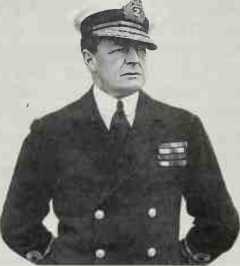Have been. In any event, gun calibres went up from 12in to 13.Sin to ISin. Ships grew correspondingly in size and armour. Interestingly, after the awkward layout of the early dreadnoughts’ five turrets, the designs building in 1914 were reverting to something similar to the pre-dreadnought layout of turrets at either end of the superstructure, but now using the superfiring arrangement of the first American dreadnoughts, with two turrets at either end. A further answer to cramming the maximum possible guns into the space available was triple (and later quadruple) mountings.
By the time the Washington Treaty of 1921 put a virtual stop to battleship building for some 15 years, 16in guns had become the latest standard. Apart from the 18in of the monster Japanese Famato-class - the largest battleships ever built, in an attempt to confront American numbers with sheer size — gun size did not increase. However, when construction of the last generation of battleships started on the eve of World War II, size increased further. This was due to the increased threat from under and above the surface — improved torpedo protection, heavy anti-aircraft protection and increased deck armour against bombs. Also the new battleships were given battlecruiser speeds, approaching or even exceeding 30 knots, which meant much greater engine power and therefore size.
Even after the experience of war had shown the vulnerability of battle. ships to attack from the air and confirmed the danger from underwater attack, there were still occasions at night or in bad weather when only a battleship could match another of the same kind. Today, only the Americans are left with heavily armoured and gunned ships, which gives them a great advantage in that most modern naval weapons are no longer designed to cope with battleships. Not only are the four lowas useful shore bombardment vessels, they are also very formidable fighting ships. DJL.
Bayerlein, Lt Gen Fritz (18991970). Ger. Established a brilliant reputation as a staff officer with Guderian’s XIX Panzer Corps in France, 1940, and 2nd Panzer
Group in the invasion of Russia, 1941. In September 1941 be went to North Africa as cos, Afrika Korps, serving under Rommel and Cruewell. Proving his own command capability by taking temporary control of the Afrika Korps when Nehring was wounded at Alam Haifa, August 1942, he was given a division in Italy, 1943, commanded the noted Panzer Lehr division in Normandy, 1944, and headed LIII Corps in the Rhineland and Ruhr, 1945. His postwar writings provide valuable analyses of command decisions. RO’N.
Bayonet. Invented in the 17th century, bayonets remain in use even with automatic weapons. Of many types developed, the most enduring have been the spike and knife. In both world wars and even in the Falklands War, the bayonet has featured in infantry close-quarter fighting.
Bazentin le Grand and Bazentin le Petit. Villages in the German second line on the Somme, captured by the British 3rd and 7th Divisions respectively on July 14 1916. Both villages were lost, then retaken, in 1918.
Bazooka. Nickname given to the US 2.36in anti-tank rocket launcher introduced in 1942.
BE 2c, 2d, 2e: Royal Aircraft Factory (Br, WWI). Two-seat reconnaissance - bomber / fighter / trainer. Prototype flew May 30 1914; first BE 2c to rfc in France January 25 1915. Widely subcontracted; employed in many capacities on virtually all fronts. Home Defence fighters usually single-seat conversions. BE 2e most numerous variant. About
3,000 (all versions) were ordered. One 90hp raf la engine; max. speed 90mph (144kph); one 0.303in rifle, carbine or machine gun; 2301b (104kg) bombs.
Beatty, Adm of the Fleet Earl
(1871-1936). Br. Commander of the battlecruiser fleet at Jutland, c-in-c Grand Fleet 1916-18, First Sea Lord 1919-27. Beatty’s enterprise and daring earned him repeated early promotions so that by 1900 he had reached the rank of captain. Thereafter, he attracted the good opinion of the First Lord of the Admiralty, Churchill. At Jutland, he led his ships straight into action upon sighting the enemy and without waiting for Jellicoe’s main fleet to come up. In retrospect, some thought that he had acted too hastily; others that Jellicoe had done so too tardily. None, however, doubted the boldness of Beatty’s design and in the aftermath of the battle, when it began to appear that an opportunity of destroying the whole of the German High Seas Fleet had been

Jut-jawed determination: Adm Beatty
Lost, Beatty replaced Jellicoe as c-in-c.
Beatty’s prestige was an incalculable asset to the navy after the war, both during the years that he was First Sea Lord and when he found it his duty to resist the arguments and claims of Tren-chard as Chief of the Air Staff. It may, however, be doubted if the best interests of the two services were served by the contest between them. ANF.
Beauchamp-Proctor, Capt
Anthony Wetherby VC (18941921). South African. Fighter pilot, credited with 54 victories, including 16 observation balloons, while serving with the rfc and raf in France in 1918.
Beaufighter, Bristol (Br, WWII). Night fighter/shipping strike; crew 2/3. Prototype flew July 17 1939; to squadrons September 1940. Used in UK, Europe, Mediterranean, Western Desert, Far East. Production (364) in Australia; total production (all Marks) 5,918. Two l,770hp Bristol Hercules XVII engines; max. speed 303 mph (485kph); 2,1271b (965kg) torpedo, 5001b (225kg) bombs or eight 901b (40kg) rockets, four 20mm cannon, one 0.303in machine gun.




 World History
World History









